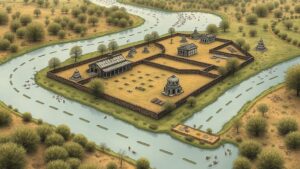Searching for the rumored “City of Silver†in the Patagonian wilderness of South America.
The Quest for the City of Silver in Patagonia
Deep within the rugged and uncharted landscapes of South America, whispers of a legendary city known as the City of Silver continue to captivate explorers, treasure hunters, and historians alike. This lore, deeply rooted in the 16th century, has sparked countless expeditions into the mountainous terrains of Patagonia, a region characterized by its diverse ecosystems and daunting geography.
Historical Background
The legend of the City of Silver, often associated with the name Cibola, gained traction after the Spanish Conquistadors, including figures such as Francisco Pizarro and Hernán Cortés, returned from their explorations with tales of vast treasures discovered in the Americas. It is believed that the city is hidden somewhere in the southern regions of Chile or Argentina, with early references dating back to the 1520s.
As the tales spread, many Spanish expeditions were launched from the coastal port of Santiago, Chile, into the wilderness in search of this affluent city. Although none succeeded in their quests, the stories endured, transforming into a tantalizing mix of myth and history.
Geographical Challenges
Patagonia presents a series of unique geographical challenges that complicate the search for the City of Silver. The region is notable for its:
- Extensive fjords and mountain ranges.
- Dense forests and vast plateaus.
- Extreme weather conditions, including strong winds and rainfall.
For example, the winds in the Patagonian steppe can reach speeds of over 100 km/h, making navigation perilous. Also, areas like the Cordillera Darwin, with peaks rising over 2,000 meters, can be almost inaccessible, posing significant hurdles for modern explorers.
Notable Expeditions
The search for the City of Silver has led to numerous expeditions throughout the years. In 1958, an expedition led by American archaeologist John M. C. Muir traversed the Andes, focusing on Patagonia based on historical accounts from early explorers. Despite extensive mapping and artifact collection, the elusive city remained unfound.
In 1990, another significant attempt was made by a group of Argentine and Chilean archaeologists who utilized advances in satellite imagery to identify potential sites. Though they uncovered numerous indigenous artifacts and evidence of ancient settlements, these findings did not lead to the discovery of the fabled city.
Modern Discoveries and Technology
With the advent of modern technology and interdisciplinary methods, the search continues. Drones, LiDAR (Light Detection and Ranging), and ground-penetrating radar are now employed to explore regions previously deemed inhospitable.
For example, in 2022, researchers from Universidad de Buenos Aires utilized LiDAR to scan dense forest areas, revealing potential archaeological sites that merit further investigation. Such technologies can make it easier to uncover land features that were previously hidden under thick vegetation.
Cultural Significance
The quest for the City of Silver is more than just a treasure hunt; it reveals a significant aspect of cultural history in South America. For indigenous peoples, such stories often signify deeper connections to land and heritage.
Plus, the narratives surrounding the city illustrate the European colonization narrative, reflecting the valuation of land and resources and the impact of treasure hunting on native populations. Understanding these dynamics is crucial for contemporary explorers and conservationists dedicated to preserving the regions cultural heritage.
Current Perspectives and Archaeological Ethics
Interest in the City of Silver holds implications beyond simple archaeology. As treasure hunting continues in popular culture, there is a growing call for ethical practices. Organizations advocate for the preservation of archaeological sites rather than their exploitation for personal gain.
For example, UNESCO recognizes the significance of responsible archaeology and cultural preservation, emphasizing the importance of local community engagement in archaeological projects. Ensuring that indigenous populations benefit from the exploration of their ancestral lands is increasingly prioritized.
Conclusion: The Ongoing Adventure
The pursuit of the City of Silver remains an enduring adventure, full of historical intrigue and contemporary challenges. As explorers and researchers adopt innovative techniques and methodologies, the dynamic interplay between myth and reality continues to unfold.
For those captivated by this tale of hidden treasure, the journey is not only about finding the city itself but also about understanding the broader implications of exploration in Patagonia. Whether through fieldwork or virtual exploration, the allure of the City of Silver will likely continue to inspire generations to come.
Actionable Takeaways
- Explore reputable literature and documentaries to understand the historical context of the City of Silver legend.
- Support ethical archaeological practices that prioritize cultural heritage and community involvement.
- Consider participating in volunteer programs that focus on archaeology and conservation in historical sites within Patagonia.



